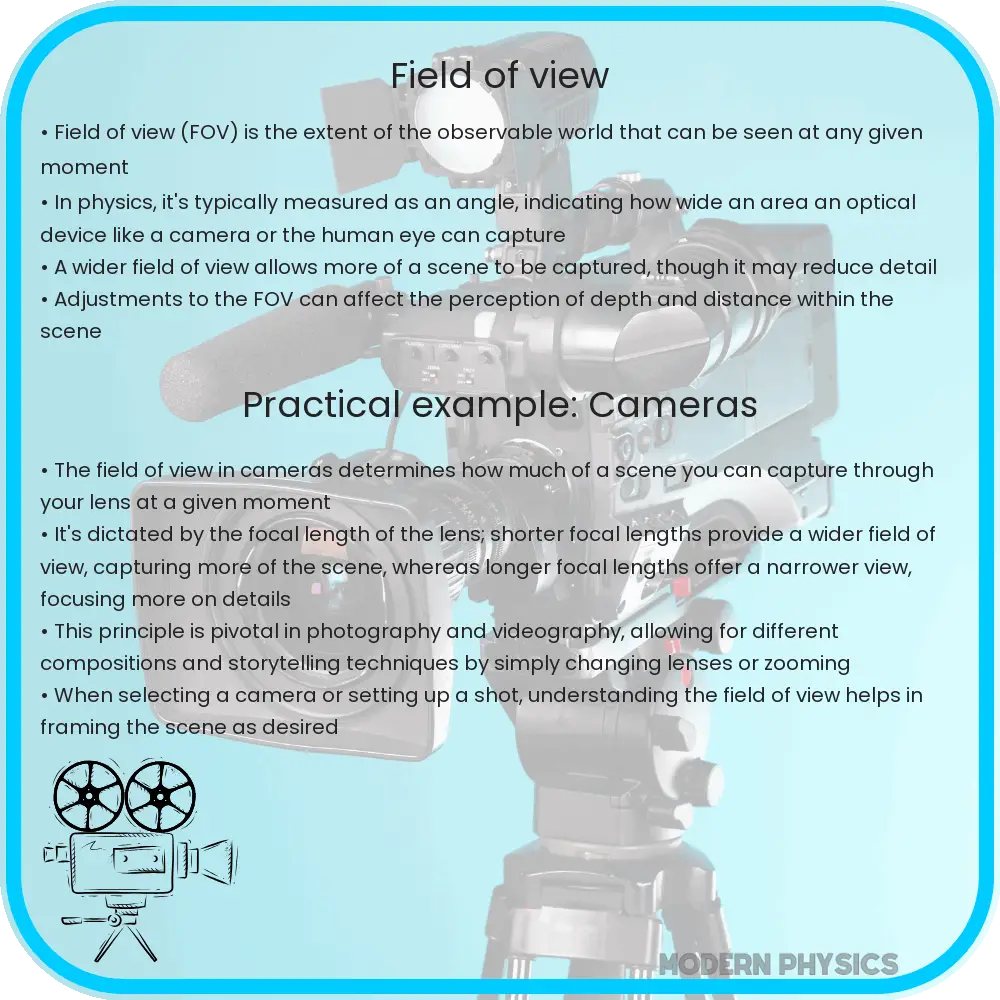Explore the role of Field of View in geometric optics and human vision, its impact on clarity, applications, and how it shapes our visual experiences.

Understanding Field of View in Geometric Optics and Vision
The concept of Field of View (FOV) is crucial in both geometric optics and human vision. FOV refers to the extent of the observable world that can be seen at any given moment, whether through an optical device or the human eye. This article delves into the principles of FOV in the context of geometric optics and its implications for vision and clarity.
Geometric Optics: Basics and FOV
Geometric optics is a branch of physics that deals with the study of light as rays. In this context, FOV is determined by the optical design of lenses and mirrors. The key factors influencing FOV in lenses include focal length, aperture, and the lens’ physical size. A lens with a shorter focal length provides a wider FOV, enabling a broader area to be captured in the image. This principle is widely applied in photography, telescopes, and binoculars.
- Focal Length: It’s the distance between the lens and the image sensor when the subject is in focus. Shorter focal lengths yield a wider FOV.
- Aperture: This refers to the opening through which light enters a camera or optical device. A larger aperture allows more light and can influence the depth of field, indirectly affecting the perception of FOV.
- Lens Size: Larger lenses can capture more of the scene, thereby increasing the FOV.
Human Vision and FOV
In terms of human vision, FOV encompasses all that can be seen without moving the eyes. It includes central and peripheral vision. The average human horizontal FOV is about 200 degrees, with about 120 degrees being binocular vision (overlapping field of both eyes) and the rest being peripheral vision. The vertical FOV is typically narrower, around 135 degrees. These aspects of human FOV are essential in understanding visual perception and clarity.
Several factors can influence the human FOV, including:
- Anatomy of the Eye: The size and shape of the eyeball, the positioning of the eyes, and the health of the eye structures all play a role in determining FOV.
- Neurological Factors: The brain’s ability to process visual information affects how we perceive our FOV. Conditions like glaucoma can reduce FOV, leading to tunnel vision.
Applications and Importance of FOV
The concept of Field of View is not only theoretical but also has practical applications in various fields. In photography and cinematography, FOV is essential for framing and composing shots. In medical fields, especially in ophthalmology, understanding FOV helps in diagnosing and treating visual impairments. In virtual reality (VR) and augmented reality (AR), FOV plays a critical role in creating immersive experiences. A wider FOV in VR headsets makes the virtual environment more realistic and engaging.
Improving Clarity through FOV Optimization
Optimizing FOV is crucial for clarity in both optics and vision. In optical devices, selecting the right lens based on the desired FOV can significantly enhance image clarity. In human vision, maintaining good eye health is essential for preserving a wide and clear FOV. Regular eye examinations are vital for early detection and treatment of conditions that might narrow the FOV.
Technological advancements are continuously expanding the possibilities in the manipulation and enhancement of FOV. High-definition lenses, advanced VR headsets, and innovative surgical techniques are just a few examples of how technology is enhancing our visual experience, both through devices and natural vision.
Conclusion
In conclusion, Field of View plays a pivotal role in both geometric optics and human vision. Its understanding is crucial for professionals in photography, filmmaking, ophthalmology, and emerging technologies like VR and AR. The principles governing FOV in optics provide a foundation for designing lenses and optical devices that capture wide and clear images. Similarly, in human vision, a comprehensive understanding of FOV and its influencing factors is essential for maintaining visual health and clarity. As technology continues to evolve, the manipulation and enhancement of FOV are bound to open new horizons in visual experiences, making it an exciting field of ongoing research and development.
